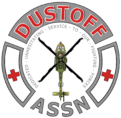Retired Col. Leonard A. Crosby had a thirst for knowledge and a passion to teach others what he knew. He died in May 2005.
“He was a real forward-thinking person,” said Mary Crosby, his wife of 62 years. The forward-thinker was also a creator of one of the Army’s most used services, MEDEVAC, or using helicopters to remove wounded soldiers from combat. Leonard Crosby, called “Andy” by most, was an Army medic and medical command instructor for more than 30 years. The Elizabethtown resident died Tuesday at age 83. The Crosby home is filled with certificates, medals and other honors from Crosby’s military career. There are silver stars, bronze stars, commendation medals and medals from World War II and Korea.
There’s also a well-worn book: “The history of the U.S. Army Medical Corps.” Crosby’s name is on several pages, mainly for his role in the invention of MEDEVAC. He was drafted into the Army in 1942, serving in World War II as part of an ambulance company. Crosby’s unit was the first ambulance company on the scene after the D-Day invasion in Normandy, France, his wife said. “He accomplished amazing things in his 83 years,” said his son, Michael Crosby.
One of the most amazing accomplishments started in 1950, in Korea. Leonard Crosby was serving as the evacuation officer for the 8th Army. He noticed that the military was having a difficult time evacuating wounded soldiers from combat because of Korea’s hilly roads, which were often blocked, preventing ambulances from getting to the field. Helicopters at that time were primarily used for artillery, Mary Crosby said. Her husband wrote the rulebook on how to use them in a medical evacuation situation. Leonard Crosby was in charge of the first demonstration of medical helicopters in the summer of 1950 at Taegu Teachers’ College in Korea. After his years in combat, Leonard Crosby became an instructor at several military schools. He also served as chief of staff of medical command in Europe, and executive officer of the medical command at Walter Reed Army Hospital.
